India: Land of Eternal Ink
Article © 2009 Lars Krutak
Madhya Pradesh
One hundred years ago in Mandla, it was reported that both male and
female Khonds were heavily tattooed, though the custom among men was
already dying out. Baiga men also wore markings consisting of chandrama
(moon) on the back of the hand and bichhu (scorpion) on the forearm.
Sometimes they also tattooed themselves on painful areas of the body in
an attempt to cure rheumatism.
A Khond or Bhumia girl was first tattooed when she was just a few
years old: on the forehead and temples, and on the right cheek. The
pattern is the same for both tribes. On the forehead just above the nose
is the figure of the hearth tattooed in the form of a horseshoe (Fig.
19). The open side points downwards and a dot appears on each side of
it; one dot is also marked below. This tattoo mark is called chulwa
("the hearth") and is a symbol of the girl's future household duties.
The tattoo marks on the temples and on the right cheek (dipa) consist of
several lines and dots. They are applied at the same time or a little
later. When a girl reaches puberty, she is tattooed on the arms, chest
and shoulders (Fig. 20). If she receives these marks after marriage, her
parents are responsible for payment. Later, just before or after
marriage, she may also be tattooed on the back of her legs and on her
thighs (Fig. 21). Not all women displayed equal amounts of tattooing
because by local standards it was an expensive practice and only the
"wealthy" could afford extensive tattooing.
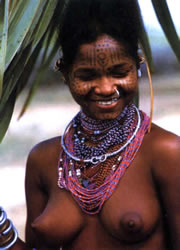 |
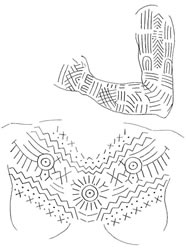 |
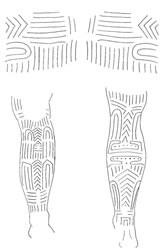 |
|
Fig. 19) Bhumia woman |
Fig. 20) Drawings of Bhumia patterns |
Fig. 21) More Bhumia patterns
|
Among the Baigas, tattoos were applied by professional tattooers (badnin)
of the Badna caste called Godnaharin. Today, they continue to ply their
client's bodies at fairs and weekly bazaars. Pigments included a mixture
of the juice of the bhilawan tree (Semicarpus anacardium) or a
concoction of the cast and burnt skin of a snake (the domi is preferred)
mixed with black til (Sesame indicum) and some ramtilla (Guzotia
abyssinica) oil. The skin is pricked with a needle and additional juice
rubbed into the wound. Nowadays, tattooists use electric machines
operated by dry cell batteries. After the design is completed, it is
washed with cow-dung water or soap-nut liquid. The soap-nut water
provides a cooling effect and decreases the pain. Soap-nuts are also
strung on a thread and placed around the necks of small children in the
belief that this device helps them cut their teeth and protects them
from evil spirits.
The traditional pricking process was extremely painful and one elder
commented long ago that "we don't give them any drugs. It hurts for
seven or eight days and swells up. Then it gets right, and they find
they have something that no one will ever take away from them." When a
girl screams during her tattoo session, the old women laugh at her and
say, "If you cannot bear godan (tattooing), how will you endure chodan
(intercourse)? "It is said that tattooing should not commence during the
monsoon season because of increased danger of infection.
For the Baiga women themselves, their tattoos are considered to be a
form of sexual expression and a powerful sexual stimulant. A Baiga man
once said, "When she is well tattooed, then our sinful eyes declare her
beautiful. A light-colored girl needs it; how lovely she looks when she
wears bangles that match the line of tattooing!"
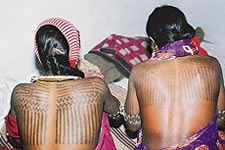 |
|
Fig. 22) Baiga back tattooing
|
When a Baiga woman was asked about the significance of her tattoos
around 1935, she replied "Desire!" "If you buy bangles, they will break.
But if you are tattooed, it will last forever." Another said they are
like "a jacket that can never be taken off. These marks are the only
things that are certain to go with us to the grave and beyond it." Of
course, there is a Baiga belief that a woman's tattoos can be sold after
death. On the back appears the figure dhandha which is comprised of six
dots joined together by lines (Fig. 22). One elder stated, "after death
Bhagavan [the Supreme Being] takes everything from us, but if there is
one dhandha he can't solve it [it's like a riddle], then he has to put
that mark on the child into whose body the jīv [soul] would be
reincarnated."
Interestingly, Baiga men were traditionally forbidden from witnessing
the tattooing operation. And tattooed girls or women had to undergo a
two-day period of seclusion whereupon they were covered with turmeric
and oil and then bathed. If a man witnessed the rite, or if a Baiga girl
failed to receive her markings, it was believed that Bhagavan, their
Supreme Deity, would dig holes all over her body with an iron bar after
death.
Baiga women interviewed in the 1990s said that their tattoos also
prevented arthritis, made them immune to weather changes, poisonous
substances would never affect them, and that their tattoos increased
their ability to fight blood-related disorders.
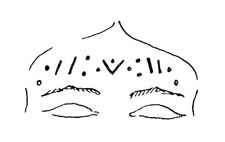 |
|
Fig. 23) Baiga forehead markings
|
According to tradition, when a Baiga girl reached about eight years
of age she received a "V" mark tattooed in the center of her forehead
(Fig. 23). Apart from this design, three dots and a vertical and
horizontal line were also tattooed. The tattooist is given some
turmeric, salt, chili and a coin wrapped in the leaves of mahlol which
are then placed in a supa. She blesses the girl and is paid a sum
(twenty rupees in 1999). Other Baiga tattoo motifs included peacocks or
a dauri (basket) on the breast, and the turmeric root (haldi-gāth) on
the arm; these are given when the girl reaches puberty. At or after
marriage, various patterns (jhophari) were next pricked on the back of
the hand and lines of dots (palāni or kajeri) on the thighs. On the knee
was placed the phulia motif that resembles a flower, and on the back are
flies, men, the sakri or magic chain, and the dhandha designs. On the
legs are fish-bones and chakmak (steel).
Around 1930, forehead tattoos cost one anna, four annas for each arm,
and four more for the breast markings. Thigh markings cost eight annas,
legs four, and five annas for the back. In the 1990s, the expenses
associated with marking the entire body approached one hundred rupees.
Amongst the Muria Khonds, women were tattooed by female relatives or
by other women. In some districts, however, Muria women were tattooed by
wandering Ojha women who plied their skins. Tattoo ink was prepared from
charcoal dust and pounded incense mixed with til or mahua oil. The
mixture is placed in a broken shard of pottery, covered, and burnt over
a lamp or small fire. A shell is used to scrap the deposit and the ink
is stored in a small pot or coconut shell. The tattooist manufactures a
"pen" of bamboo and draws the desired pattern on the skin. Just before
she begins to prick her client with a needle instrument she calls out
the names of the Seven Sisters of Bara Deo - their Supreme Protector.
And during the tattooing she may sing one or more songs like this one:
"Listen to our prayer. Yours is the promise we made that day. Let the
burning of the needles cease."
Once the tattooing has been completed, the artist receives from her
client's relatives a payment of rice, haldi (turmeric), oil, chilies and
salt. This she waves about the girl she has tattooed. Sometimes, she
holds the needles and turmeric in her right hand, grabs hold of the
first fingers of the person she has just tattooed in her left and with
the right makes three passes around her client's body. This ritual
action, as well as the tattooist's offering of a small portion of her
payment to the Seven Sisters, is supposed to "cool" the tattoo marks.
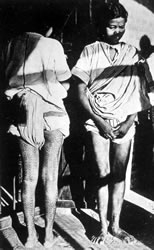 |
|
Fig. 24) Khond ghats |
To this day, tattooing is still very common among women and they are
tattooed over a large part of the body. The legs of Khond women are
completely marked with sets of parallel lines. These are called ghats or
"steps" (Fig. 24). Sometimes interspersed at intervals is another figure
called sankal or "chain". One early 20th century writer stated that
perhaps "the idea is to make the legs strong for climbing."
As in other regions of India, tattooing amongst the Khonds, Bhumia,
and Baiga seems to have been originally a magical means of protecting
the body against real and spiritual dangers, much in the same manner as
the wearing of talismans. It was also supported that people were
tattooed with images of their "totem" in order to better identify
themselves with it. The following account was taken from a Baiga priest
ca. 1915 who frequented a popular shrine in Mandla. His wife was a
tattooer of both Baigas and Khonds, and the magical intent of tattooing
is clearly brought out:
"On the sole of the right foot is a triangular device that represents
the earth and will have the effect of preventing the woman's foot from
being bruised and cut when she walks about barefoot. On the sole of the
left foot an oval tattoo is seen. It is meant to be in the shape of a
foot, and is called Padam Sen Deo or Foot-god. This deity is represented
by stones marked with two footprints under a tree outside the village.
When they have a pain in the foot they go to him, rub his two stones
together and sprinkle the dust from them on their feet as a means of
cure. The device tattooed on the foot no doubt performs a similar
protective function.
On the upper part of the foot five dots are made, one on each toe,
and a line is drawn round the foot from the big toe to the little toe.
This sign is said to represent Gajkaran Deo, the elephant god, who
resides in cemeteries. He is a strong god, and it is probably through
this symbol on the feet that enables women to bear weight. On the back
of the legs they have images of the Baiga priest and priestess. There
are also supposed to give strength for labor, and when they cannot go
into the forest from fever or weakness they say that Bara Deo, as the
deified priest is called, is angry with them. On the upper legs in front
they tattoo the image of a horse, and at the back a saddle between the
knee and thigh. This is Koda Deo the horse-god, whose image will make
their thighs as strong as those of a horse. If they have pain or
weakness in the thigh they go and worship Koda Deo, offering him a piece
of saddlecloth. On the outer side of each upper arm they tattoo the
image of Hanuman, the deified monkey and the god of strength, in the
form of a man. Both men and women do this, and men apply burning cow
dung to the tattoo-mark in order to burn it effectually into the arm.
This god makes the arms strong to carry weights.
Down the back is tattooed an oblong figure, which is the house of the
god Bhimsen, with an opening at the lower end just above the buttocks to
represent the gate. Inside this on the back is the image of Bhimsen's
club, consisting of a pattern of dots more or less in the shape of an
Indian club. Bhimsen is the god of the cooking-place [and rain], and the
image of his club, in white clay stained green with the leaves of the
semar tree, is made on the wall of the kitchen. If they have no food, or
the food is bad, they say that Bhimsen is angry with them. The pattern
tattooed on the back appears therefore to be meant to facilitate the
digestion of food, which the Khonds apparently once supposed to pass
down the body along the back. On the breast in front women tattoo the
image of Bara Deo, the head on her neck and the body finishing at her
breastbone (Fig. 25A). The marks around the body represent stones,
because the symbol of Bara Deo is sometimes a basket plastered with mud
and filled with stones. On each side of the body women have the image of
Jhulan Devi, the cradle goddess, who is represented by small figures
attached to Bara Deo.
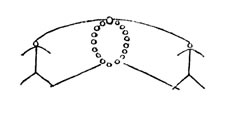 |
|
Fig. 25A) Bara Deo
tattoo |
But a woman cannot have the image tattooed on her till she has borne
a child. The place where the image is tattooed is that where a child
rests against its mother's body when she carries it suspended in her
cloth, and it is supposed that the image of the goddess supports and
protects the child, while the mother's arms are left free for work.
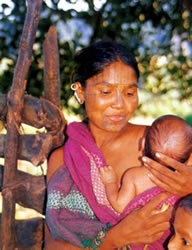 |
|
Fig. 25B) Khutia
Khond tattooing
Photograph © Michael Laukien |
Round the neck they have Kanteshwar Mata, the goddess of the
necklace. She consists of three to six lines of dots round the neck
representing bead necklaces. On the face below the mouth there is
sometimes the image of the cobra, and it is supposed that this will
protect them from the effects of eating any poisonous thing. On the
forehead women have the image of Chandi Mata (Fig. 25B). This consists
of a dot at the forehead at the parting of the hair, from which two
lines of dots run down to the ears on each side, and are continued along
the sides of the face to the neck. This image can only be tattooed after
the hair of a woman has been parted on her marriage, and they say that
Chandi Mata will preserve and guard the parting of the hair, that is the
life of the woman's husband, because the parting can only be worn so
long as her husband is alive. Chandi means the moon, and it seems likely
that the parting of the hair may be considered to represent the bow of
the moon."
Of course, there are various accounts relating to the origins of
tattooing in Madhya Pradesh and one is given below:
"Bara Deo was the son of Kadrengal and Tallur Muttai [Mother Earth].
He had six brothers and seven sisters. One day the seven sisters went to
Tallur Muttai and asked her for ornaments such as would last even after
death. Kadrengal gave Bara Deo a dhol and a dhamru drum. Then two sons
were born to Bara Deo. One was called Murha [Muria] and the other Ojha.
Bara Deo taught Murha to beat the dhol with wooden sticks on the ground.
Because he beat with wood on the ground Murha became a ploughman but
Ohja played his dhamru slung from his shoulder, and spent his life
hunting and drawing patterns on the walls of houses.
In this way the Ohja's wife learnt how to tattoo and once a year the
Ohja gives a goat to Bara Deo saying, 'Behold, we go all over the world
tattooing. From the marks we make let there be no wound, no pus, no
swelling. Let no evil magic attack us as we work.' Because of this, Bara
Deo lives with the Ohja and no witch can injure them at the time of
tattooing."
A Bhumia woman also spoke about the importance of her tattooing. "If
we die and do not have any markings we will not have anything of beauty
to show in the afterlife. We are tattooed to show Bhagavan [Supreme
Being] something that will please him."
Similarly, the Muria Khonds considered tattooing to be a kind of
"passport" to the afterlife. "If she dies without being tattooed,
Mahapurub [Creator god] will punish her. But if she brings him beautiful
drawings from the Middle World, he will keep her with him and look after
her."
It has also been recorded that "sorcerers" were tattooed with some
image or symbol of their Deo or "god" on the chest or right shoulder,
and believed that this deity would always remain with them and that any
evil magic directed against them would fail.
Next Page
|
1
|
2
|
3
|
4
|
5
|








